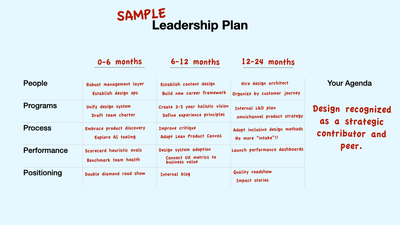What is "good design," anyway?—it's crucial for design orgs to define quality
When a design team is small, fewer than 10 people, design quality can be successfully managed informally—reviews, crits, swivel-the-monitor discussions. The Head of Design can reasonably keep tabs on all the work, and, through discussion, drive their team toward higher quality.
As design teams grow into design orgs, this oral culture approach frays. The Head of Design can't see all the work. Quality is determined by design managers and team leads, who may have varying opinions as to what good looks like. The larger the team gets, the more chaotic this view of quality becomes. Additionally, a larger design org is part of an even larger product development org, which ends up exponentializing the voices commenting on design quality.
With all this noise, the only way to handle design quality at scale is to establish clear frameworks, guidelines, patterns, and measures of success that can shift local discussions of design quality from personal preferences and toward organization-wide references.
What surprises me is that pretty much every design organization I engage with, regardless of size, still maintains that folkloric approach to quality. This is dangerous, because, at the end of the day, all a design org has to show for itself is the quality of the work it produces. If there are no standards, if that quality is all over the map, that reflects poorly on the design function as a whole.
The trick is, how does one define design quality? Our colleagues in software engineering have it easier—there are industry-standard criteria (reliability, efficiency, security, maintainability) with clear metrics. These criteria all pretty much hew to "how well does the code function for the needs of the machine?"
Design quality, though, is perceived in the messy context of people and business. When we say that a design is "good," what do we mean? How do we distinguish that from "great"? How do we articulate a quality framework so that everyone on the team understands what is expected in terms of the sophistication of their work? (When I work with VPs of Design, I ask them, "How do we inform a 25-year-old junior designer in your most distant office what good looks like?")
Over time, I've developed a an approach to establishing design quality within an organization. There are a slew of components:
- Usability heuristics
- Brand personality characteristics
- Experience principles
- Design guidelines / design system
- Inclusive design and accessibility practices
- Measures of success
- Explained exemplars of quality work
- Mature and inclusive critique practices
Usability Heuristics
In 1997 I took Richard Anderson's UC Extension class on "User-Centered Design and Usability Engineering." (It is still the only formal training, outside of conference workshops, I've ever had in this field). Among the things he taught was "heuristic evaluation," a method for assessing the usability of interfaces.
Subscribe to continue reading


